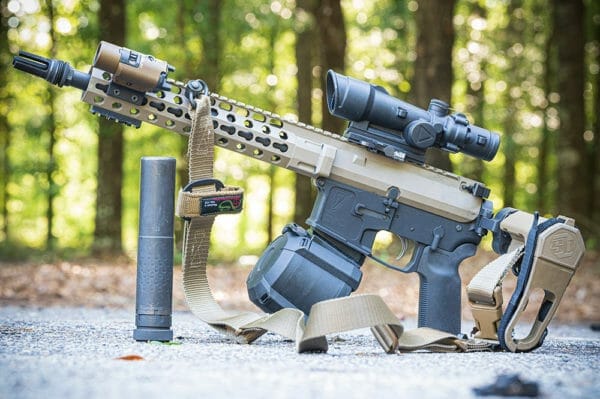
On August 1, 2023, a three-judge panel for the United States Court of Appeals for the Fifth Circuit issued an order which found the “Final Rule” of the ATF concerning pistol braces to be unlawful. Part of the “Final Rule” claimed pistol braces, combined with legal pistols, made the combination “short barreled rifles” subject to the regulatory requirements of the National Firearms Act (NFA). This contradicted years of previous findings by the ATF. The three-judge panel sent the case back to the trial court for a ruling on a preliminary injunction and on what injunctive relief is called for. The case is Mock v Garland.
The three-judge panel decision was split. Two judges, Don R Willett and Jerry E Smith, were in the majority. Judge Stephen A Higginson dissented. The decision is one of several involving the controversial “Final Rule” of the Biden administration ATF. It may be the Biden Administration will ask the Fifth Circuit to hear the case en banc, or the Biden administration may appeal the decision to the Supreme Court. Of particular interest is the concurrence written by Judge Don Willett. Judge Willet went on record as opining the regulation/law which defines pistols with shoulder stocks as “short barreled rifles” may well be unconstitutional by itself, without the regulatory mismanagement of the ATF in this case. From the order of the Court, page 41:
Don R. Willett,Circuit Judge, concurring:
I join the majority’s careful opinion in full measure. I write separately because I suspect that the Final Rule would likely fail constitutional muster even if it were a logical outgrowth of the worksheet idea that preceded it.
Rearward attachments, besides making a pistol less concealable,improve a pistol’s stability, and thus a user’s accuracy. Accuracy, in turn, promotes safety. Even for attachments that convert a pistol into a rifle under the statutes, ATF has not identified any historical tradition of requiring ordinary citizens to endure a lengthy, costly, and discretionary approval process just to use accessories that make an otherwise lawful weapon safer.
Instead, the NFA tends to regulate weapons that inflict indiscriminate destruction: “machinegun[s]”,short-barreled “shotgun[s],” and “smooth bore” weapons (and for that matter, “explosive[s]”, “grenade[s]”, and “poison gas”).1 Weapons that begin as rifles, too, are more difficult to keep accurate once the barrel starts shrinking.
In my view, protected Second Amendment “conduct” likely includes making common, safety-improving modifications to otherwise lawfully bearable arms.2 Remember: ATF agrees that the weapons here are lawfully bearable pistols absent a rearward attachment. Congress might someday try to add heavy pistols to the NFA and the GCA, but it hasn’t yet. These pistols are therefore lawful. Adding a rearward attachment—whether as a brace or a stock—makes the pistol more stable and the user more accurate. I believe these distinctions likely have constitutional significance under Bruen.
The dissenting Judge, Stephen A Higginson, disagrees. From the dissent by Judge Higginson on page 56:
I disagree that these braces are, in relevant regard, “safety-improving modifications.” After all, as a plurality of the Supreme Court has observed, it is “clear from the face of the [NFA] that [its] object was to regulate certain weapons likely to be used for criminal purposes,” and “the regulation of short-barreled rifles . . . addresses a concealable weapon likely to be so used.” United States v. Thompson/Ctr. Arms Co., 504 U.S. 505, 517 (1992) (plurality opinion) (emphasis added). Indeed, as some commenters observed in response to ATF’s proposed rule, “short-barreled rifles are uniquely dangerous because they ‘combine the power of shoulder-mounted rifles with the concealability of handguns’ and . . . ‘stabilizing braces’ are functionally equivalent to shoulder stocks.” Final Rule at 6,498. Other commenters, “including former law enforcement officers,” favored the proposed rule because braced pistols, “as evidenced by their use in the Boulder[, Colorado] and Dayton[, Ohio] mass shootings, ‘are unusually dangerous because they can be easily concealed like a handgun but have the firepower and accuracy of a rifle.’” Id. (emphases added). Increased concealability and accuracy, at least in the hands of killers, is not “safe”—it is lethal.
Judge Higginson does not mention the Thompson/Ctr. Arms Co. case occurred long before the Heller decision in 2008, the McDonald decision in 2011, or the Bruen decision in 2022. Those decisions would now be relevant to the 1992 case but did not exist when the case was settled. Moreover, Judge Higginson conveniently does not mention handguns with shoulder stocks are less concealable than handguns without shoulder stocks. This argument is a variation of the “guns are bad, and more guns are worse” simplistic premise shown to be false over the last 50 years and more. Shoulder-stocked handguns were not considered during the Congressional debate in 1934. They were not formally found to be “short barreled rifles” until 1961. Handguns with shoulder stocks were commonly used for lawful purposes long before the 1934 law was passed. They are not “dangerous and unusual.” They are bearable arms in common use, protected under the Second Amendment. Judge Willet is showing how this may be seen by the Supreme Court.
Following this line of reasoning, it should be expected silencers/suppressors or gun mufflers would also be protected under the Second Amendment. A shoulder stock is an accessory that makes a protected arm safer and more effective. Exactly the same can be said of a silencer/suppressor.
About Dean Weingarten:
Dean Weingarten has been a peace officer, a military officer, was on the University of Wisconsin Pistol Team for four years, and was first certified to teach firearms safety in 1973. He taught the Arizona concealed carry course for fifteen years until the goal of Constitutional Carry was attained. He has degrees in meteorology and mining engineering, and retired from the Department of Defense after a 30 year career in Army Research, Development, Testing, and Evaluation.

from https://ift.tt/AoVsvSY
via IFTTT

No comments:
Post a Comment